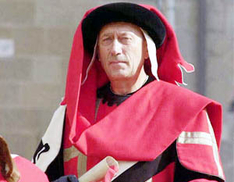
You can’t start describing Arezzo without having described the capital of province which gave her this name. Middle age traditions have found new life here. Twice a year the citizens of the city hold a procession in the streets with jugglers and equestrian shows which ends with the tournament of middle age knights. The Archeological museum in Arezzo keeps the memory of the ancient times. It was named after Maecenas who’s name became a common name for all the patrons of art. The collection of bronze statuettes found in excavations of necropolis Poggio del Sole and outstanding ceramics (I BC – I AD) are the most famous exhibits in the museum.
Piazza Granda is the central square in Arezzo. It is one of the most beautiful and unusual squares in Tuscany and in the whole Italy. It is peculiar for its trapezoid form and inclined location. The difference of some levels makes 10 metres! The square is surrounded with buildings dated by XIII-XVII centuries. There is Palazzo Cofani-Brizzolari in the South and middle age buildings with typical wooden balconies in the East. Palazzo Lappoli custom - designed by Giorgio Vasari for Cosimo I Medici wholly occupies rising northern part of the square. The Palace with clock at the front attracts the attention in the western part of Piazza Granda. The unique mechanism counts down not only time but also days of the week, lunar phases and solar motion.
Pieve di Santa Maria church is an amazing middle age monument in Arezzo. It is considered to be one of the finest buildings in Italy built in Roman style. The front is decorated with galleries and arcades. Each of the front columns is unique. San Francesco church is famous thanks to series of frescoes (Affreschi della leggenda della vera croce) by Piero della Francesca. The frescoes are in perfect condition as they have been recently restored.
Palazzo Pretorio used to be the residence of the invited podesta. The coats of arms of all posestas who had been ruling the city since 1434 are placed in the front. The tradition to invate podestas was common in middle age Italy. The citizens believed in Podesta’s excellent ability to be an umpire as he didn’t have any roots, friendly, financial and other relations with townspeople.
The so called Petrarca house with its library and academy is situated near the Palace. Vasari house is worth visiting as well. Famous architect had lived there before moving to Florence. Nowadays it’s the museum which exhibits frescoes and portrets created by Vasari and also paintings of XVI century, mostly works of Tuscan school.
Duomo cathedral overtops on the peak of San Pietro hill. The cathedral was built in honour of saint Donato, the patron of the city. The erection of the building started in 1278, basic construction work were finished by 1510 and the front of the building got the present look only in the beginning of XX century. Special attention should be paid for picturesque stained-glass windows inside.
Il Prato garden is a favourite place for airing and festivals. It is situated behind the cathedral and spreads out to Medici castle.
Erected in XIX-XX centuries Palazzo della Provincia is one of the latest places of interest. Many tourists visit this place to see the fresco of Adolfo de Carolis with the image of 29 most famous citizens of Arezzo who left significant mark in the history of humanity.
The streets and the squares of the capital once became fascinating scenery for “Vita e Bella, La / Life Is Beautiful” by Roberto Benigni.
See also

|
The Saracen Tournament in Arezzo
The so-called Saracen Tournament, “Giostra del Saracino”, is organized in Arezzo annually. It is held on the third Saturday of June and on the first Sunday of September.
The Saracen Tournament has a long history. The contest held on the 6th of August, 1535 is mentioned in the old papers of Arezzo.
|
No comments